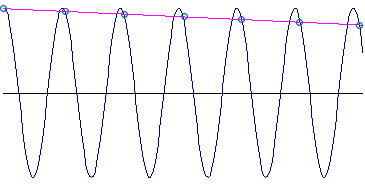WHY DOES ONE NEED AN ANTI-ALIASING FILTER ? Imagine you digitize a 1020 Hz sine wave signal at 1000 samples-per-second and plot the digitized wave on the computer display. What would you see? It turns out you would see a pure 20 Hz sine wave. The reason is because the sine wave would progress approximately one entire cycle in between digitized points, as illustrated below. The dark blue sine wave is your original 1020 Hz signal. The tiny circles are your digitized points. And the pink line is what happens when you plot the digitized points on the computer display. The plotted wave does not look like the original, and is misleading to the viewer.
Nyquist
Aliasing
Aliasing Error
Anti-Aliasing Filter (AFS)
instruNet i500 Anti-Aliasing Filter
More Information |
